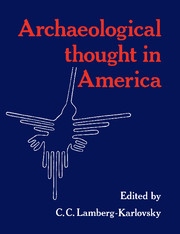Book contents
- Frontmatter
- Contents
- List of illustrations
- Introduction
- Part I History, method, and theory
- Part II Archaeology in the Americas and beyond
- 9 The structural analysis of Paleolithic art
- 10 Ancient China and its anthropological significance
- 11 Settlement pattern studies and evidences for intensive agriculture in the Maya Lowlands
- 12 The political economy of the Inka empire: the archaeology of power and finance
- 13 An epigenetic view of the Harappan culture
- 14 The use and abuse of world systems theory: the case of the “pristine” West Asian state
- 15 Mesopotamia, Central Asia and the Indus Valley: so the kings were killed
- 16 New tracks on ancient frontiers: ceramic technology on the Indo-Iranian Borderlands
- 17 Pastoralism and the early state in Greater Mesopotamia
- References
- Index
11 - Settlement pattern studies and evidences for intensive agriculture in the Maya Lowlands
Published online by Cambridge University Press: 06 July 2010
- Frontmatter
- Contents
- List of illustrations
- Introduction
- Part I History, method, and theory
- Part II Archaeology in the Americas and beyond
- 9 The structural analysis of Paleolithic art
- 10 Ancient China and its anthropological significance
- 11 Settlement pattern studies and evidences for intensive agriculture in the Maya Lowlands
- 12 The political economy of the Inka empire: the archaeology of power and finance
- 13 An epigenetic view of the Harappan culture
- 14 The use and abuse of world systems theory: the case of the “pristine” West Asian state
- 15 Mesopotamia, Central Asia and the Indus Valley: so the kings were killed
- 16 New tracks on ancient frontiers: ceramic technology on the Indo-Iranian Borderlands
- 17 Pastoralism and the early state in Greater Mesopotamia
- References
- Index
Summary
Settlement patterns and agricultural practices are obviously interrelated subjects so that it is fitting that they be treated jointly. This is especially so in a context of Lowland Maya archaeology for in the last three decades ancient settlement patterns and Prehispanic agriculture have been closely related research concerns. Questions and findings about one have prompted queries and discoveries about the other in an interrelated research circle. This present chapter is an attempt to summarize some of that research.
It will be my aim to present basic data on settlement and agriculture and inferences deriving from these about ancient Maya demography and sociopolitical structure. These presentations and inferences will compose the larger part of what I have to say, but, in addition, I would like to consider some recent translations of Maya hieroglyphic texts which provide information that bear upon old Maya political structure and territoriality. While this information supplements the inferences drawn from settlement patterns, it also offers some interesting contradictions.
Introductory background
The Lowland Maya archaeological area includes the Guatemalan Department of Peten, bordering portions of the Mexican states of Chiapas and Tabasco, all of the Mexican Yucatan peninsula, the Republic of Belize, and a small fringe of western Honduras (see map, Fig. 11.1). This is territory that was occupied by Maya-speaking peoples from remote prehistoric times until today – specifically by the Yucatec, Choi, and Chortian branches of that large language family.
- Type
- Chapter
- Information
- Archaeological Thought in America , pp. 167 - 182Publisher: Cambridge University PressPrint publication year: 1989
- 6
- Cited by



